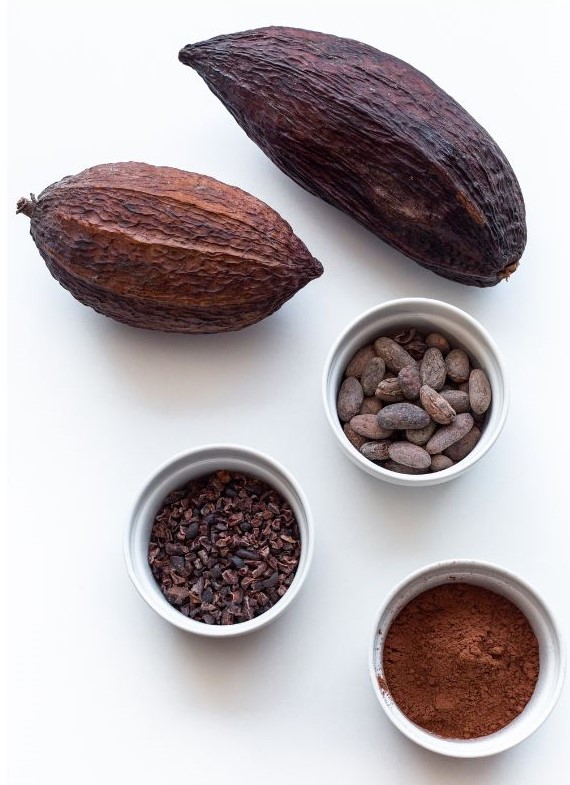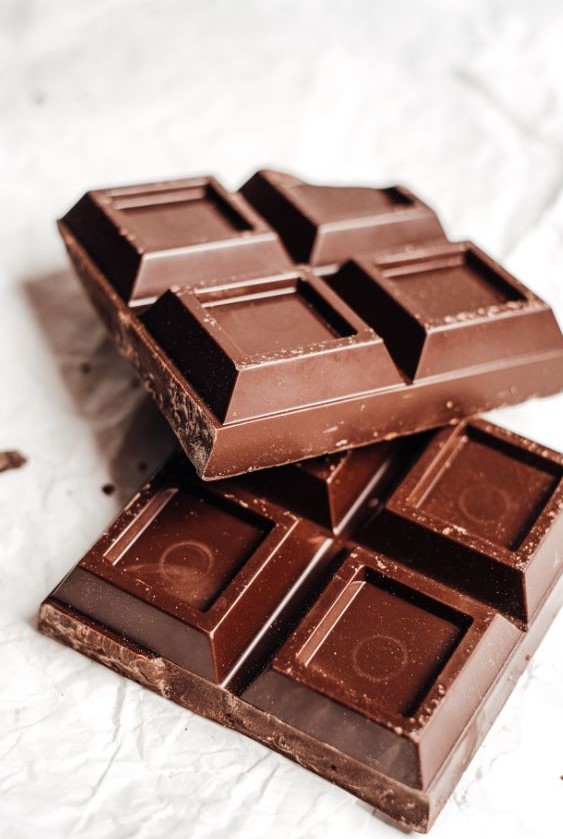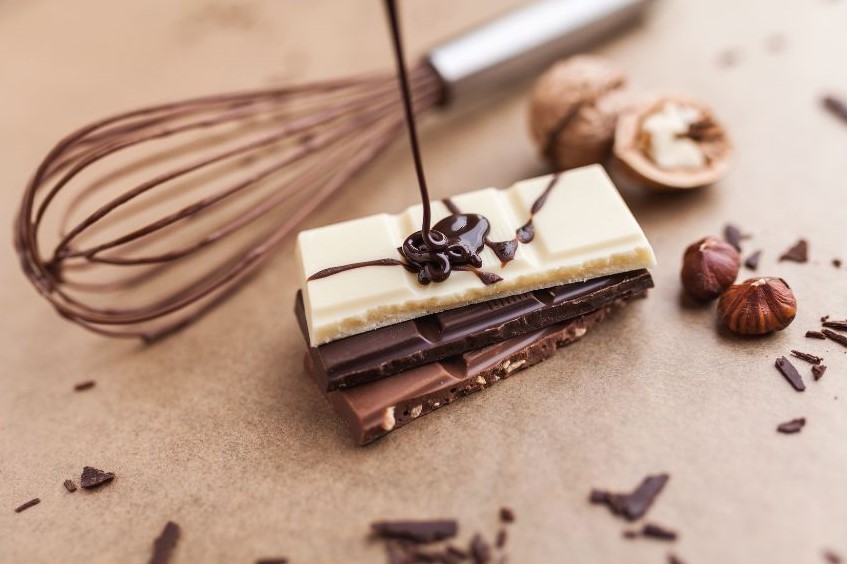Chocolate… it’s a favorite of many, signifying all things delightfully special, and decadent!
Whether in its simplest form or in a more complex dessert, chocolate is a versatile ingredient. Use it as the main attraction, a complimentary ingredient, or used as a garnish. It pairs well with many ingredients, sometimes in surprising ways. Think fruit, creamy ingredients, nuts, herbs, warm spices, and of course, a nice glass of wine or port.
And, much more than just a pretty flavor, good quality dark chocolate is rich in flavanols, antioxidants, and minerals that support heart and brain health, elevate mood, help lower blood pressure, and lessen the chance of cancer and diabetes.
When cooking with chocolate, some processes are easy – simply add the chips, wafers, or powder to the recipe. Other uses may require a few more steps and care – like melting or tempering. No matter what the application, here are six tips to aid in achieving good results when working with chocolate.
1. BECOME FAMILIAR WITH THE DIFFERENT TYPES OF CHOCOLATE
All chocolate originates from cacao beans. When those beans are processed, a variety of types and forms of chocolate are created – unsweetened, bittersweet, dark, semi-sweet, milk, and white.
Here’s where things can become confusing – there is no set standard for the amount of cacao in each type of chocolate. Manufacturers create their own product formulas, so the percentage of cacao (ground-up cocoa beans), and any added ingredients, can differ. This affects the flavor, color, and texture of the final chocolate product, and also means that some types of chocolate can be used interchangeably in recipes based on the cacao content. When selecting chocolate for cooking, it’s easiest to look for cacao or cocoa percentages listed in a recipe, rather than rely on the type of chocolate (dark, bittersweet, semi-sweet, and so on). It’s also helpful to keep in mind that generally, the higher the amount of cacao, the less sugar it has, and the stronger, possibly more bitter, the chocolate flavor.
- Unsweetened baking chocolate is 100% pure cacao without any sugar. It has a bitter flavor and most often comes in powdered form. It works well in baking or cooking when additional sugar needs to be carefully balanced.
- Bittersweet chocolate is made with a high percentage of cacao (oftentimes at 70% or higher) which reflects its namesake – slightly bitter, less sweet, and a bit fruity. It tends to be somewhat dry and crumbly in texture. It is less sweet than most dark chocolate, yet not as sweet as semi-sweet or milk chocolate. Although it can be eaten as is, it is generally used in cooking and baking where it is combined with other ingredients. It comes in powdered, bar, block, chip, or wafer form.
- Dark chocolate has the highest amount of cacao (between 50% – 90%), and the least amount, if any, of added sugar. Dark chocolate is generally dairy-free, but it is best to check packaging labels to be sure. This type of chocolate is often used in baked goods and desserts, and for melting. It is also considered the healthiest choice for chocolate as it contains the highest level of flavanols, making it a popular choice for enjoying on its own as a treat. It can be found in powder, bar, block, chip, or wafer form.
- Semi-sweet chocolate contains more sugar than dark or bittersweet chocolate and can have anywhere from 50% – 65% cacao. Some manufacturers market semi-sweet chocolate as “dark” chocolate, yet its makeup and flavor profile is definitely sweeter than true dark chocolate. It is most often found in bar, chip, or wafer form.
- Milk chocolate generally contains 10% – 30% cacao, but can go as high as 50%. Along with more added sugar than other types of chocolate, it also contains some amount of dairy. Milk chocolate is often used in baking and candy making. It is most often found in bar, chip, or wafer form.
- White chocolate does not contain any cacao solids so some say it is not truly chocolate! It is made from cocoa butter, sugar, and milk. It is generally used in desserts, baked goods, and candy making, and can be found in bar, block, chip, or wafer form.

2. DECIDE WHICH FORMAT WORKS BEST
Chocolate is sold in various formats – bars, blocks, chips, wafers, or powder. After deciding which type of chocolate, choose a format that also fits your purpose.
- Bars and blocks can be chopped or shaved, melted, or enjoyed as is. When melting chocolate, chop or break the bar into small, similar sized pieces, then place into a bowl or other device and melt as directed by the recipe.
- Chips and wafers contain an added ingredient to help them hold their shape so are best used as is in baking, rather than for melting.
- Powder can be incorporated into liquids such as beverages, batters, and sauces.
3. CHOOSE QUALITY CHOCOLATE FOR BETTER RESULTS AND HEALTH BENEFITS
No matter what type of chocolate you are using, choose one with a higher amount of cacao. The higher the amount of cocoa or cacao means the lower amount of sugar in the chocolate. This is especially important in cooking and baking, as added sugar in ingredients can affect the outcome of the final dish or baked good.
Also, check ingredient labels – manufacturers may add unwanted and unneeded ingredients as a way to lower costs. Lower-quality chocolates contain higher amounts of butter fat, oils, artificial flavors and colors, and other additives that can negatively affect cooking and baking, as well as health and well-being.
For the most health benefits, choosing chocolate that has 65% cacao or higher, a low amount of added sugar, and no additives is highly recommended.
4. STORE CHOCOLATE PROPERLY FOR BEST RESULTS
When stored properly, chocolate can last one to two years. To ensure the longest shelf life, store it in a tightly sealed container in a cool, dark place (around 60 – 75° F).
Avoid refrigerating uncooked chocolate (bars, blocks, chips, wafers) unless temperatures are quite hot, as it will develop a white coating, or “bloom”. This does not affect the flavor or quality of the chocolate, yet may not appear as appealing. If a recipe containing chocolate shavings or such requires refrigeration, wrap the item properly and allow it to come close to room temperature before serving.

5. AVOID MIXING WATER WITH CHOCOLATE
When melting chocolate, the use of a double boiler is often recommended. The moist, gentle heat radiating from the lower pan allows the chocolate pieces in the upper pan or bowl to slowly melt, lowering the chance of scorching or burning. The process works very well, yet be mindful that water and chocolate do not mix! Even a small amount of water splashing into the melting chocolate will cause it to seize and possibly become unusable.
When using the double boiler method to melt chocolate:
- Keep the water level low enough so as to not touch the bottom of the upper pan or bowl.
- Maintain a gentle simmer at low heat rather than a rolling boil.
- Ensure that the lower pan is completely covered with the upper pan or bowl so as to lessen the chance of water splashing upward.
7. USE ROOM TEMPERATURE OR WARM BOWLS, UTENSILS, AND INGREDIENTS
Did you know that chocolate can be “shocked”? Indeed! In addition to water, melted chocolate does not like anything too cold. Avoid using a cold spoon, whisk, or another cold or metal utensil, a cold bowl, or stirring in cold ingredients such as flavorings, milk, or cream. Cold items or ingredients will cause the melted chocolate to become hard, which oftentimes cannot be undone.
The use of a wooden spoon or silicone spatula, a room temperature bowl, and room temperature or warm ingredients work best.
READY TO LEARN MORE ABOUT CHOCOLATE?
Everything You Don’t Know About Chocolate – Melissa Clark, NYTimes, Feb 2020
Playing with Chocolate – YouTube video by America’s Test Kitchen
– how it’s made, easy tempering, and more…
How to Melt Chocolate: A Step-by-Step Guide – The Food Network
– Stovetop and microwave methods for melting various forms of chocolate
How To Temper Chocolate Without a Thermometer – Dana Velden, The Kitchn, updated Oct 2, 2022
– Double-boiler method without a thermometer
Tempering Chocolate: Microwave Method – Lake Champlain Chocolates
– Microwave method with a thermometer
RECIPE
Chocolate Bark with Nuts, Seeds, Dried Fruit
SHARE
Tell us one thing you currently make or would like to make that uses chocolate. We love hearing your ideas!
Main photo: and.one from canva
Other photos: Vie Studio from Pexels, and Allie Yound from Pexels
© 2022 Love + Craft Kitchen, LLC, All Rights Reserved


Recent Comments